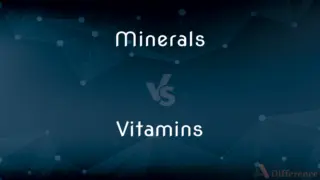Chondrocytes vs. Osteocytes — What's the Difference?
By Tayyaba Rehman — Published on November 10, 2023
Chondrocytes are cells found in cartilage, providing flexibility and resistance, while osteocytes are mature bone cells crucial for maintaining bone mass and density.

Difference Between Chondrocytes and Osteocytes
Table of Contents
ADVERTISEMENT
Key Differences
Chondrocytes and Osteocytes represent two critical cell types involved in forming and maintaining skeletal structures within the body. Chondrocytes are exclusively found in cartilage, a flexible connective tissue found in various parts of the body. Osteocytes, on the other hand, are located within the bone and play a pivotal role in its maintenance and functionality.
In the realm of Chondrocytes, these cells are fundamental to the production and maintenance of the extracellular matrix of cartilage, a type of connective tissue. In contrast, osteocytes reside in the lacunae of the bone matrix, signifying a sturdy and rigid environment. Osteocytes are derived from osteoblasts and play a significant role in bone remodeling by communicating with other bone cells.
Chondrocytes primarily involve themselves in maintaining the cartilage, which serves as a cushion between joints and aids in smooth movement. The absence of blood vessels in cartilage results in a limited repair capability, as nutrients cannot be directly supplied to chondrocytes. Conversely, osteocytes are responsible for orchestrating the balance of bone resorption and deposition, vital for maintaining the skeletal system's structural integrity.
Understanding the physiological relevance of Chondrocytes, it’s evident that their functionality in producing and maintaining the matrix of cartilage is fundamental to joint health. Osteocytes, dwelling within our bones, regulate both the formation and resorption of bone tissue, ensuring optimal bone health and facilitating skeletal support and protection to various organs.
In a nutshell, Chondrocytes and osteocytes perform distinct yet mutually inclusive roles within the musculoskeletal system, ensuring structural stability and facilitating mobility. Both cell types are critical to understanding bone and joint disorders, opening avenues for therapeutic interventions in osteoporosis, osteoarthritis, and various other skeletal disorders.
ADVERTISEMENT
Comparison Chart
Primary Location
Found in cartilage
Reside in bones
Function
Maintain and produce cartilage matrix
Regulate bone mass and facilitate bone remodeling
Blood Supply
Avascular (no direct blood supply)
Have access to blood supply through bone's vascular system
Repair Capability
Limited due to lack of direct blood supply
Better repair capability due to access to nutrients via blood supply
Associated Disorders
Associated with conditions like osteoarthritis
Related to conditions like osteoporosis
Compare with Definitions
Chondrocytes
Specialized cells that produce and maintain cartilaginous matrix.
The injury impaired the chondrocytes, limiting the cartilage repair.
Osteocytes
Regulators of bone mass and mineral metabolism.
The functionality of osteocytes is crucial for maintaining bone density.
Chondrocytes
Cells that lack a direct nutrient supply from blood vessels.
Without vascular access, chondrocytes rely on diffusion for nutrient intake.
Osteocytes
Mature bone cells derived from osteoblasts.
Osteocytes are fundamental in maintaining the structural integrity of bones.
Chondrocytes
Vital components in facilitating smooth joint movements.
Healthy chondrocytes ensure that our knee joints move effortlessly.
Osteocytes
Cells that possess dendritic processes to communicate with other cells.
Osteocytes utilize their dendritic processes to interact with osteoblasts and osteoclasts.
Chondrocytes
Primarily involved in synthesizing collagen and proteoglycans.
Chondrocytes actively synthesize collagen to maintain cartilage structure.
Osteocytes
Involved in the physiological process of bone turnover.
The activities of osteocytes directly impact bone resorption and formation.
Chondrocytes
Cells that reside within the lacunae of cartilage.
Chondrocytes remain isolated in lacunae, devoid of blood vessels.
Osteocytes
Cells that reside within the lacunae of the bone matrix.
Osteocytes communicate with other bone cells to regulate bone remodeling.
Chondrocytes
Plural of chondrocyte
Osteocytes
A branched cell embedded in the matrix of bone tissue.
Osteocytes
Plural of osteocyte
Common Curiosities
Are Chondrocytes and Osteocytes similar?
While both are associated with the skeletal system, chondrocytes are involved with cartilage, and osteocytes are related to bone, serving different functions.
How do chondrocytes function in the body?
Chondrocytes produce and maintain the cartilaginous matrix, which provides resistance and flexibility within the joints.
What is the primary role of Osteocytes?
Osteocytes regulate bone mass, communicating with other bone cells to facilitate bone remodeling and maintain mineral homeostasis.
What are osteocytes?
Osteocytes are mature bone cells residing within the bone matrix, vital for maintaining bone mass and regulating mineral homeostasis.
Can chondrocytes regenerate cartilage effectively after an injury?
Chondrocytes have limited regenerative capacity due to the avascular nature of cartilage, often resulting in imperfect repair.
What are Chondrocytes?
Chondrocytes are cells located in cartilage, responsible for producing and maintaining the cartilaginous matrix.
How do osteocytes communicate within the bone structure?
Osteocytes communicate through dendritic processes, interacting with other bone cells and managing the exchange of nutrients and waste.
How do osteocytes originate within the bone?
Osteocytes originate from osteoblasts, transitioning to a mature state and becoming embedded within the bone matrix.
What factors can impact the health and function of osteocytes?
Factors such as age, nutritional deficiencies, and hormonal imbalances can adversely affect osteocyte function and subsequently, bone health.
What is the role of osteocytes in skeletal health?
Osteocytes are crucial for bone remodeling, balancing bone formation, and resorption to maintain skeletal health.
Why is cartilage avascular and how does it affect chondrocytes?
Cartilage is avascular to provide a smooth, frictionless surface for joints. This limits the repair capabilities of chondrocytes as they lack a direct nutrient supply.
What is the significance of chondrocytes in osteoarthritis?
In osteoarthritis, the degradation of cartilage occurs, and chondrocytes play a key role in this process due to their involvement in cartilage maintenance.
What components are produced by chondrocytes to form cartilage?
Chondrocytes produce components like collagen and proteoglycans, essential for forming the sturdy yet flexible cartilage matrix.
How do chondrocytes and osteocytes contribute to movement and stability?
Chondrocytes maintain cartilage that facilitates smooth joint movement, while osteocytes maintain bone density providing skeletal stability.
Can the roles of chondrocytes and osteocytes be interchanged in the skeletal system?
No, chondrocytes and osteocytes serve specialized, non-interchangeable roles in maintaining cartilage and bone health respectively.
How are osteocytes related to conditions like osteoporosis?
Osteocytes regulate bone density, and their dysfunction can lead to imbalances in bone resorption and formation, contributing to osteoporosis.
What are the differences in the living environments of chondrocytes and osteocytes?
Chondrocytes reside in an avascular cartilage matrix, while osteocytes are embedded within the vascularized bone matrix.
Share Your Discovery

Previous Comparison
Minerals vs. Vitamins
Next Comparison
Native App vs. Web AppAuthor Spotlight
Written by
Tayyaba RehmanTayyaba Rehman is a distinguished writer, currently serving as a primary contributor to askdifference.com. As a researcher in semantics and etymology, Tayyaba's passion for the complexity of languages and their distinctions has found a perfect home on the platform. Tayyaba delves into the intricacies of language, distinguishing between commonly confused words and phrases, thereby providing clarity for readers worldwide.












































